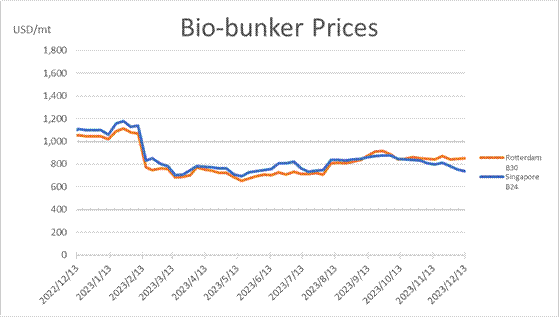|
Indications for VLSFO with a bio-mix of a maximum of 30% in Rotterdam were at $843.00-863.00/mt, strengthening from the previous week. Deals were reportedly done at a premium of $290-300/mt to FOB Rotterdam Barges 0.5% and at a premium of $170-180/mt to Singapore 0.5%S fuel oil.
The EU Emissions Trading Scheme (EU-ETS) would apply to the maritime sector from January 2024. There were growing views of strengthening demand for bio-bunkers as an alternative to conventional bunker fuel oil. European carbon allowance (EUA) prices as of Dec 13 were trading at Euro 68's per ton of CO2.
B30 prices in Rotterdam slightly rose from the previous week reflecting firm buying interest. International prices of UCO-based FAME (including UCOME) remained in the low-$1,000's/mt, moving within a narrow range. The upper end of prices were capped as bio-bunker demand expansion in Asia was limited.
Indications with a bio-mix of a maximum of 24% in Singapore were at $787.00-807.00/mt, extending losses from a week ago in reaction to weak demand.
In the first half of 2023, demand had expanded for VLSFO with a maximum bio-blend ratio of 24%, mainly in Asia and Europe on a trial basis. However, in the second half of the year, buying interest subsided. Demand stagnation particularly in Asia kept prices at the current levels. In 2023, there was supply tightness of certified biofuels due to fires at Neste's Singapore refinery and the Martinez Bio Refinery in California, jointly owned by Neste and Marathon Oil.
There were growing views that demand would increase for bio-bunkers primarily in Europe in 2024. Approximately 10% of bunker sales in ARA were expected to shift to alternative fuels such as bio-bunkers and LNG bunkers. Currently, it stands at around 7%. The usage of these fuels significantly impacts corporate financing and stock prices, contributing to a smooth transition in Europe. Additionally, the increase in certified suppliers accredited by organizations such as ISCC and REDcert might lead to price competition, facilitating increased demand. However, there were an expectations in the Netherlands that subsidies for bio-bunkers and fossil fuels would be reduced by up to half after 2024, potentially causing a slowdown in price competition from mid-2024 onwards.
Bio-bunkers demand in Asia centered around Singapore was expected to weaken. Due to the Carbon Intensity Indicator (CII) scheme that commenced on Jan 1, 2023, many shipping companies were focusing on improving fuel efficiency through slow-steaming operation rather than sourcing alternative fuels. Market participants pointed out the need for expanding subsidies and presenting greater benefits than purchasing existing fuels to further encourage the switch to bio-bunkers.
Ship owners also noted that the urgent issue was the reduction of greenhouse gas emissions generated by product manufacturing and fuel combustion. Hence, many stakeholders prioritized that over considering the use of alternative bunker fuels. It seemed challenging to make a dramatic shift towards alternative fuels. In major Asian countries such as China, South Korea, and Japan, there was a lack of tax systems for biofuels that span petroleum products and petrochemicals, resulting in stagnant demand in domestic markets and as bonded bunkers. Addressing challenges such as legal framework establishment, understanding among owners, and ensuring supply stability of bio-bunkers would be necessary in 2024 onwards.

|
<PR> Information
|
|
The Bunker Oil report covers bunker oil prices and spot trades at 40 major ports around the world.
It also contains the trend of future fuels such as LNG bunkers and bio-bunkers, container handling volumes, and port operations. LNG bunkers and bio-bunker prices are reported on a weekly basis.
If you learn more, please click the icon on the right side.
|

|
|




